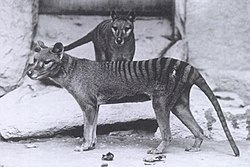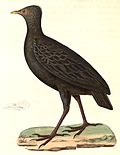

This is a list of Australia-New Guinea species extinct in the Holocene that covers extinctions from the Holocene epoch, a geologic epoch that began about 11,650 years before present (about 9700 BCE) [a] and continues to the present day. [1]
Contents
- Mammals (class Mammalia)
- Platypus and echidnas (order Monotremata)
- Carnivorous marsupials (order Dasyuromorphia)
- Bandicoots and bilbies (order Peramelemorphia)
- Kangaroos, possums, wombats, and allies (order Diprotodontia)
- Rodents (order Rodentia)
- True insectivores (order Eulipotyphla)
- Bats (order Chiroptera)
- Carnivorans (order Carnivora)
- Birds (class Aves)
- Cassowaries and emus (order Casuariiformes)
- Landfowl (order Galliformes)
- Waterfowl (order Anseriformes)
- Pigeons and doves (order Columbiformes)
- Rails and cranes (order Gruiformes)
- Shorebirds (order Charadriiformes)
- Albatrosses and petrels (order Procellariiformes)
- Boobies, cormorants, and allies (order Suliformes)
- Hawks and relatives (order Accipitriformes)
- Owls (order Strigiformes)
- Parrots (order Psittaciformes)
- Perching birds (order Passeriformes)
- Reptiles (class Reptilia)
- Squamates (order Squamata)
- Amphibians (class Amphibia)
- Frogs (order Anura)
- Ray-finned fish (class Actinopterygii)
- Anglerfish (order Lophiiformes)
- Galaxias (order Galaxiiformes)
- Insects (class Insecta)
- Beetles (order Coleoptera)
- Fleas (order Siphonaptera)
- Book lice, bark lice, and sucking lice (order Psocodea)
- Arachnids (class Arachnida)
- Ticks (order Ixodida)
- Snails and slugs (class Gastropoda)
- Order Stylommatophora
- Clitellates (class Clitellata)
- Order Opisthopora
- Fungi (kingdom Fungi)
- Lichenized fungi (order Lecanorales)
- Red algae (division Rhodophyta)
- Order Ceramiales
- Plants (kingdom Plantae)
- Lycopods (class Lycopodiopsida)
- Ferns (class Polypodiophyta)
- Flowering plants (clade Angiospermae)
- See also
- Notes
- References
The Australian continent is also called Australia-New Guinea or Sahul to avoid confusion with the country of Australia. The continent includes mainland Australia, Tasmania, the island of New Guinea, the Aru Islands, and other nearby islands. Australia-New Guinea is divided between three countries: Australia (mainland Australia and Tasmania), Papua New Guinea (eastern New Guinea), and Indonesia (Western New Guinea and the Aru Islands). Extinct species from the rest of Indonesia are covered in List of Asian animals extinct in the Holocene. Species from the outlying islands of the country of Australia and the Bismarck Archipelago of Papua New Guinea are included below. The Solomon Islands archipelago, split between Papua New Guinea (Autonomous Region of Bougainville) and the country of Solomon Islands, is covered in List of Oceanian species extinct in the Holocene.
The fauna of Australia-New Guinea is unique. Marsupials and monotremes also existed on other continents, but only in Australia-New Guinea did they come to dominate. Aside from marine mammals, only two orders of placental mammals are native to Australia-New Guinea: rodents and bats. Dingoes and New Guinea singing dogs are considered feral dogs (Canis familiaris) introduced by humans. [2] The Christmas Island shrew is related to Asian shrews; no members of the order Eulipotyphla are native to Australia-New Guinea proper.
New Zealand species extinct in the Holocene are listed separately. The fauna of New Zealand is distinct from Australia-New Guinea. Birds, including numerous flightless birds, are the most important part of New Zealand's vertebrate fauna. Bats are New Zealand's only native land mammals. [3]
Numerous species have disappeared from Australia-New Guinea as part of the ongoing Holocene extinction, driven by human activity. Most Australian megafauna disappeared in the Late Pleistocene, considerably earlier than in other continental landmasses. [4] As a result, Australian Holocene extinctions generally are of modest size. Most Holocene extinctions occurred after the European settlement of Australia, which began with the First Fleet in 1788 CE. [5] [6] However, the thylacine, Tasmanian devil, and Tasmanian nativehen were extirpated from mainland Australia thousands of years before European settlement, although they survived in Tasmania. [7] [8] [9] The Norfolk swamphen [10] and several New Guinea mammals also disappeared before European colonisation.
In Australia, plants and animals are listed as extinct at the federal level under the auspices of the Environment Protection and Biodiversity Conservation Act 1999. [11]






































































